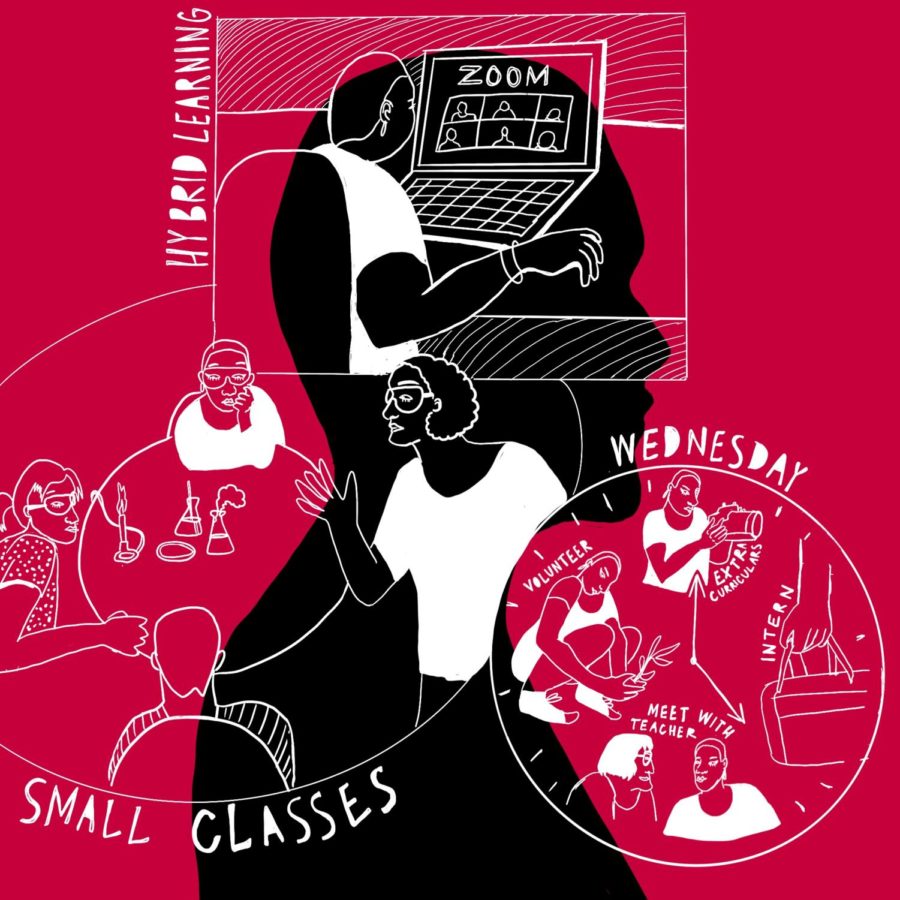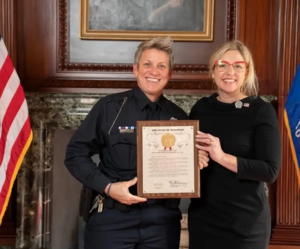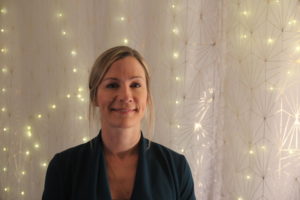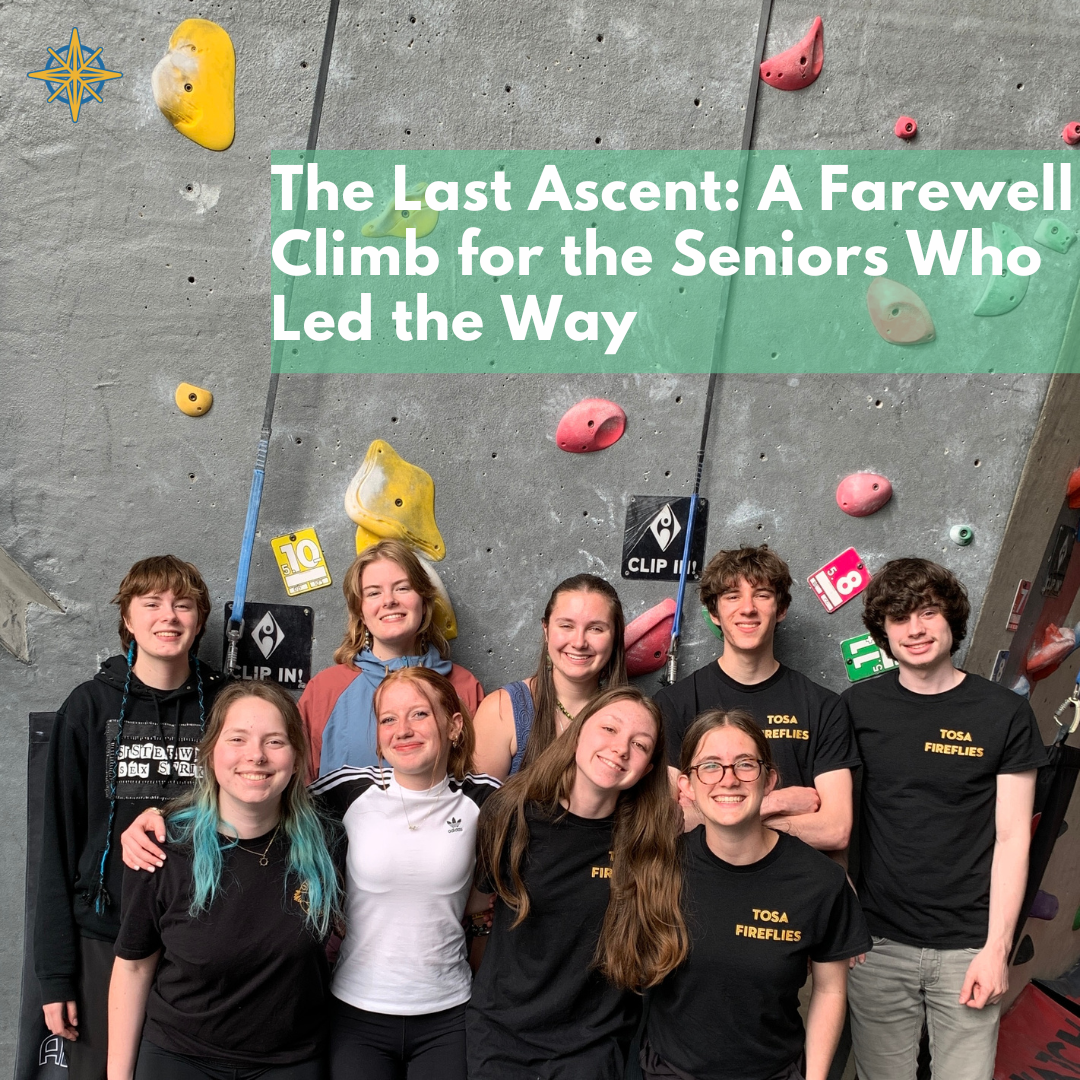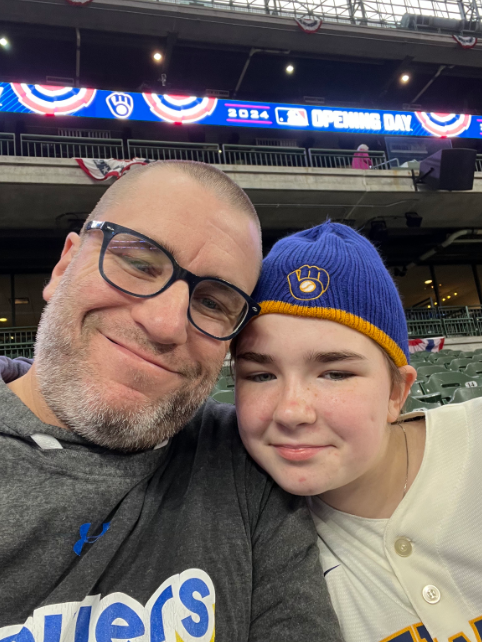Reimagining Education After the Pandemic
Graphic designed and created by Evelyn Skyberg Greer, a sophomore at Wauwatosa West.
September 20, 2021
The COVID-19 pandemic caused many structural changes to our education systems. While a lot of people are eager to move on from the COVID-19 adjustments that were enforced in public schools, others see the past 17 months of adaptations as a chance for our schools to evolve the educational standards.
Wauwatosa East English teacher Tanya Keenan believes that the smaller classroom sizes that were adopted in response to the Covid-19 pandemic were beneficial for both educators and students.
“I loved the small classes. I got to know students better and it was more intimate. I was grateful the classes were small so I could make better relationships,” she said. “I felt like I could get to know the students better and have more interpersonal connections [with students],” Keenan said. “There is more time with [individual] students. It’s harder when you have more students. I think you can have more connection with your teacher when you’re not in a big class,” she said.
Wauwatosa East Sophomore, Ryen Felix, found the small classes helped her to concentrate more and make connections with her peers.
“Smaller classroom sizes really helped me get to know other students better,” she said. “Some people just need a small group to understand lessons more than a large group, because large groups can sometimes get out of hand for some people.”
Felix also felt that having less people in a class made it easier to get help.
“A small group is really better for someone who struggles with understanding,” she said.
Wauwatosa East Sophomore Ash Janke also preferred the smaller number of students in each class.
“I liked having smaller classes,” Janke said. “I just don’t like to talk to people and I don’t socialize when there are bigger classroom sizes.”
Janke felt that there were less distractions present in small classes.
“I would say smaller classroom sizes make it easier to be one-on-one and ask the teacher questions,” he said. “With the bigger classroom sizes you have to worry about all the students that misbehave.”
Wauwatosa West art teacher Jessica Belich was also enthusiastic about the small number of students in each of her classes.
“Smaller classes [for art] was phenomenal,” she said. “My biggest class for art foundations was 23 [students], so still a decent size. But all my other classes were around 15 [students] and for what [we do in art class], it’s just so materials heavy, so techniques heavy, so instructions heavy, and it was amazing to be able to actually connect with those 15 people almost everyday. Whereas if I have 28 or 30 [students in a class], sometimes honestly I might not really have good one-on-one time with somebody for several days.”
“The small classes for us were a game changer, they were amazing,” Belich concluded.
Although the preference of small classes is largely universal, Nicole Marble who has worked as the director of secondary education in the Wauwatosa district for five years, and is in charge of all middle and high school curricular decisions, does not believe it would be realistic for the district to adopt small classes into a post COVID-19 classroom.
“I think if you ask anybody they will always want less students in a classroom, but I think that from a financial aspect of things that’s not always possible,” Marble said. Smaller classrooms are always desired, but at the end of the day we need to know what is realistic in terms of that even coming to fruition in the future.”
While small classes were largely supported by students and teachers, many were also enthusiastic about the asynchronous Wednesdays that were introduced at the beginning of the school year as a midweek cleaning day that allowed teachers and students a time to prep, catch up on work, and collaborate with others.
Wauwatosa East teacher Sarah Murray enjoyed having asynchronous Wednesdays in her schedule last year.
“Having Wednesdays be asynchronous and just having a midweek break was amazing.”
Murray was interested in the idea to continue an asynchronous Wednesday schedule in a post-COVID school year.
“It’s not a bad idea [to have Wednesdays remain asynchronous]. It would push us to have to get better at learning how to manage, and be more mindful about what we are giving and asking students to do. If we were to do asynch Wednesdays, do we still feel stressed about the amount of content we are getting through? If students get too much work and there is too much stress, it’s not worth it,” Murray said. “An important question would be why are we pursuing it? What is the point of not having Wednesdays?”
Murray believes that with the right motive, having asynchronous Wednesdays in future school years could be a helpful day used for internship and extra curricular flexibility.
“There could be different ideas for Wednesdays like an alternative way of learning out of a classroom where students could do volunteer service, participate in hiking club, or river cleanup,” she said.
West principal Ebony Grice also thinks that having asynchronous Wednesdays in a post-COVID classroom could lead to new and progressive ideas for the Wauwatosa district.
“We could certainly use a Wednesday to build our school community like having an inclusive conversations, or community building Wednesday where all voices are heard,” she said.
Although some students would utilize the day to work on projects or post-high school planning, some students feel like the loss of a normal school day might drag them behind.
Wauwatosa East freshman Ryen Felix feels that it is unnecessary to give students that day off. “I think [having Wednesdays be asynchronous] would be an unhelpful thing because if it is not COVID, why would you still need Wednesdays off?” She said.
Wauwatosa East Sophomore Ash Janke thinks that the introduction of asynchronous Wednesdays was an innovative idea. “[This year] definitely put a different perspective on Wednesdays,” he said.
Janke also worries about students falling behind, but thinks that having an asynchronous day during the week for extra curricular activities would be beneficial to many high school students.
“Good students will take the lead, they will run with it, and then students that say get C’s or B’s are going to be like, I can’t keep up and I am falling behind,” he said.
“If [asynchronous Wednesdays] were meant for a day where you have activities outside of school, if that’s what it’s for, that would be great,” Janke said.
Former Wauwatosa West teacher Taylor Richards found the asynchronous Wednesdays to be a helpful preparation day for teachers.
“They allowed teachers to be healthier and more effective,” she said. “We have shortened Wednesdays and we have an hour and a half at the end of the day and those are useful and important, but it is also exhausting. We have a whole day of teaching and then we are trying to do more things at the end of the day and your mind just is not as sharp and you can’t devote as much time to it.”
“[Fully asynchronous Wednesdays] allowed for us to be more present on the days that we are at school and to have better lesson plans. It adds to learning.”
Wauwatosa West English teacher Emily Jones also found asynchronous Wednesdays to be helpful, and believes it would be beneficial to reinforce a post-COVID asynchronous school day schedule.
“A lot of Wednesdays for teachers is about learning from each other, collaborating, and trying to find ways to improve our instruction,” she said. “I grew a lot from the conversations I had on Wednesdays with my colleagues and I found that it was a great reset button in the middle of the week to bounce ideas off of one another and collaborate. I would be in support of having asynch Wednesdays moving forward.”
Wauwatosa West Art teacher Jessica Belich found asynchronous Wednesdays helpful in order to give her extra time to devote to her students and giving them feedback and extra assistance.
“My asynch Wednesdays were so valuable because I could spend four to five hours of my day just giving feedback to students,” she said. “I could give each person such detailed feedback at least once a week which was awesome. I just felt like I had so much time to grade and assess, which I just typically don’t have.”
Belich found the time to be supportive in order for her to prepare for her classes.
“Our prep is very different so having that [extra] time would just give me the proper time to prepare for all these preps I have, also it gives us time to think about individuals. When we have time to work collaboratively as teachers, we talk about individuals that are either struggling or doing really great work but they need to be pushed, and [asynchronous Wednesdays] gave us the time to brainstorm together.”
She also thought that many students found the mid-week asynchronous day to be helpful.
“I think having that extra time for students was also really nice,” Belich said. “A lot of [my students] told me that they really liked having asynchronous Wednesdays just to play catch up. That they could really just use that day to dive in and just take the time to really learn that material at whatever pace they needed.”
Although the idea of continuing to have an asynchronous school day woven into future school weeks is appealing to some, Nicole Marble, the director of secondary education does not see it as a possibility because of the current requirement of instruction hours in Wisconsin, which, according to the Wisconsin department of public instruction is at least 1,137 hours of direct pupil instruction in grades 7 through 12 annually.
“Last year and this year the district had the opportunity to apply for waivers so that they are not held accountable for not maximizing the number of minutes that are expected by them. I fully anticipate that that option will no longer be on the table in subsequent school years unless we find ourselves in another dire state with the pandemic or a different global interruption to teaching and learning,” Marble said.
Although Marble does not believe this idea to be possible currently, she does hope that the district continues innovative ways of learning after the pandemic.
“If anything this year really pushed professionals out of their comfort zone and really helped professionals see that they can be innovative and they can be risk takers and if anything that is the one thing that I would like for [the district] to continue to see and lean into moving out of the pandemic.”
One of the innovations that the district adopted over the course of the past year was a concurrent learning style, in which students experience courses in a hybrid format with some days being over zoom and others being in person.
Wauwatosa West senior Ronan Piontek feels that having the asynchronous days last year gave him an opportunity to work at his own pace.
“I was actually fine for the first semester of concurrent learning when we were [in a] asynchronous-hybrid [learning format] as far as the virtual portion was concerned,” Piontek said. “There was an extent to which I was able to move more at my own pace. So if there were things that I didn’t need to review that would conventionally be reviewed with the entire class in an in-person environment, I could just move straight to the work and finish in less time than the normal school day.”
Although he feels that the asynchronous days that were built into the concurrent mode of learning were useful, Piontek also had some problems with synchronous hybrid days.
“During the second semester I was just very fatigued after being on zoom for seven to eight hours per day two days per week,” he said. “I was [also] missing out on some of the socialization opportunities that would be brought by full-day, in-person learning.”
Wauwatosa East teacher Sarah Murray found concurrent learning to make some of her other tasks more effective.
“Concurrent learning forced me to leverage the use of technology, not just for sake of content, but in a way to collaborate,” Murray said. “Things like parent-teacher conferences were a lot easier too.”
Murray found that using technology was helpful to her students as well.
“It created good preparation for the outside world through using some sort of canvas before college,” she said.
Nicole Marble, the director of Wauwatosa secondary education, believes that a hybrid form of learning might work well for some courses.
“I think more progress-based content areas lend themselves well to potentially having a more hybrid asynchronous structure. Some of our classes at the high school level already are in a hybrid fashion and already run in that manner and I think that this look at teaching and learning in this last year has opened up our eyes to potentially more opportunities for courses to run in that manner,” Marble said.
Marble also feels that concurrent learning might pose equity benefits.
“I think that a concurrent option allows for greater access to learning in which case we are providing greater equity through access for those that can’t make their way onto the brick and mortar school building that day.”
As the Wauwatosa School District starts the 2021-2022 school year, many of the nearly one and a half years of innovative changes and educational renovations that the district has overseen are being reverted back to pre-COVID school standards. Even with many motivated staff, students, and administrators wondering what the school can continue to utilize from the adaptations that were implemented due to the COVID-19 pandemic, whether or not the district will be able to apply any of these strategies without changes at a state level remains to be seen.
Evelyn Skyberg Greer, Eve Lazarski, Lucy Hildebrand, and Maeve Kaufman contributed to this article. Graphic by Evelyn Skyberg Greer.



